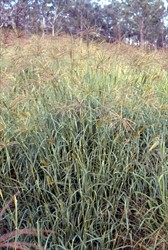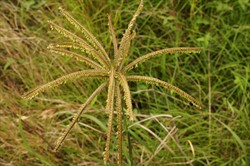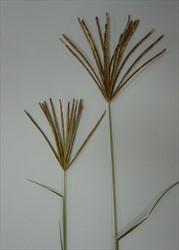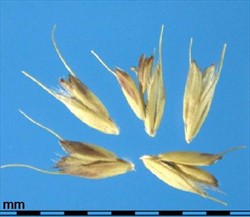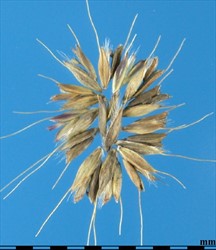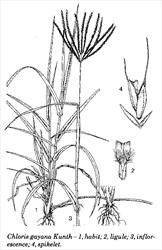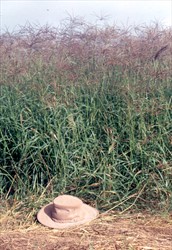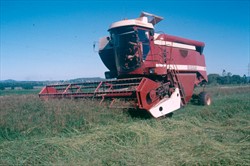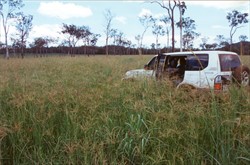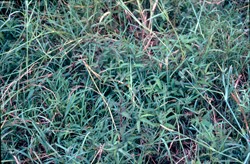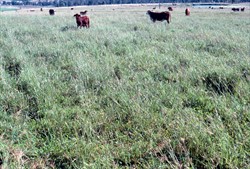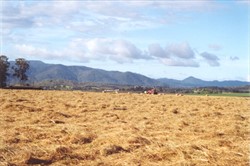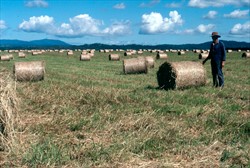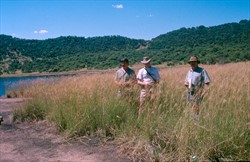Chloris gayana
Tropical Forages
Chloris gayana Kunth
Chloris abyssinica Hochst. ex A. Rich.
Family: Poaceae (alt. Gramineae) subfamily: Chloridoideae tribe: Cynodonteae.
Tufted perennial, usually stoloniferous (varies with genotype), with foliage from 0.5 to 1.2 m, and fertile tillers from 0.9 to 2 m tall. Can act as an annual in regions with extremely cold winters or long dry seasons. Stolon stems to 4 (‒5) mm diameter, fertile stems 2‒4 mm diameter. Leaves glabrous, with 2‒3 mm long hairs near the collar; blades (12.5‒) 25‒50 cm long, and (1.5‒) 3 to >9 mm wide, tapering to a fine, pointed apex. Inflorescence a digitate (single whorl) or subdigitate (double whorl), comprising (3‒) 6‒15 (‒20) ascending or spreading, spike-like racemes 4‒15 cm long, usually light, greenish brown (rarely yellow) in colour, ripening to darker brown. Spikelets about 3.5 mm long, comprising 3‒4 florets, usually one perfect with 1‒10 mm long awn, and another, male, with 1.5‒5.5 mm long awn (awn length can be useful in cultivar differentiation); sometimes all florets hermaphrodite and fertile. Caryopsis brown, 1.5‒2 mm long, 0.5 mm wide, separating readily from the spikelet in some varieties. Roots to 4.7 m deep, but sparse beyond 2.4 m. 4 million seeds (spikelets)/kg for 'Katambora', and 7‒10 million for most other varieties. About 2 million caryopses/kg.
Africa: حشيشة الرودس abu raseyn (Arabic, Sudan); apwoyo; kube (Kavirondo), erigaru, ol'piripiri-andoi (Maasai), ngondu kubwa (Solai) (East Africa); garaaji, kauarin dooki, kauarin duki (Hausa), pagamri (Fula-Fulfulde) (Nigeria); bruinvingergras, Rhodesgras, rooiklosgras, rooiklossiegras, rooiklossiesgras (Afrikaans); nyankomo (Zulu); akono, ekode (Ateso), kasibante (Luganda), businyande (Lugisu), ombagkidyanga (Luo), kuku omunene (Lusoga), orunyankokore (Runyankole/Rukiga), businyande (Gisu, Uganda)
Asia: banuko (Ilokano), koro-korosan (Tagalog) (Philippines); ya rot (Thailand); tucgiéân (Vietnam)
English: Rhodes grass, Rhodesian blue grass, Hunyani grass
Europe: chloris, herbe de rhodes (French); Rhodasgras (German)
Hebrew: עשבת המרעה
Latin America: capim-de-rhodes (Brazil); grama de Rodas, pasto de Rodas, pasto Rhodes (Spanish); zacate gordura (Costa Rica); zacate Rhodes (Mexico)
Native:
Africa: Algeria; Botswana; Egypt; Ethiopia; Kenya; Lesotho; Mali; Morocco; Mozambique; Namibia; Niger; Senegal; Somalia; South Africa; Sudan; Tanzania; Tunisia; Uganda; Zimbabwe
Macaronesia: Madeira Islands (Portugal); Canary Islands (Spain)
Naturalized:
Widely naturalized in Africa (exact native range obscure) and elsewhere in the tropics and subtropics
Forage
Used as permanent or annual forage in grass-legume or grass+N pastures in dryland and irrigated permanent systems. Can also be undersown into maize. Makes good hay if cut at or just before flowering. Generally not suitable for silage. Provides fair standover roughage when mature, better than Cenchrus ciliaris and Megathyrsus maximus due to its greater cold resistance and lower loss of dry leaves.
Environment
In some cultivation systems, it is used as a short- to medium-term pasture ley to restore soil structure, improve organic matter levels, and reduce nematode numbers. Develops good ground cover and effectively controls erosion once established (needs regular defoliation to stimulate stolon development to maintain cover). Also effectively suppresses woody regrowth provided trees and shrubs are not well established prior to planting the grass.
Other
More strongly stoloniferous types can be used in an amenity role, but may not be as effective as species such as Bothriochloa pertusa, Cynodon dactylon, Digitaria didactyla or Paspalum notatum.
Found in open woodland and grassland, riverine and lake margins, and seasonally waterlogged plains, on a wide range of soils.
Soil requirements
While preferring well-structured loams and clays of volcanic origin, C. gayana grows on most well drained soils, except very heavy clays, provided fertility is adequate. Very tolerant of high soil Na levels (conductivity >10 dS/m), particularly as HCO3- and SO4- -, but less so as Cl- or NO3-. Also tolerant of high Li+ but not Mg++. More tolerant of high than low pH, growing best in soils with pH between about 5.5 and 7.5, but will grow down to pH 4.5 (if available aluminium and manganese levels are low) and up to pH 10.
Moisture
Rainfall in its natural range varies from about 500 to 1,500 mm/yr. In cultivation, it is usually planted in areas with rainfall from 700 to 1,200 mm, but has been successful at lower annual averages. It does not thrive in areas with more than 1,800 mm rainfall. It is popular in irrigated pastures, particularly where irrigation water may be too saline for other species. Drought tolerance is less than that of Cenchrus ciliaris and Megathyrsus maximus, but can still survive in areas with a 6-month dry season, by virtue of a root system that can extract water to a depth of >4 m. Tolerates seasonal waterlogging, and up to 15 days' flooding.
Temperature
Occurs from near sea level to 2,000 m in the tropics, and sea level to >1,000 m asl in the subtropics, and from near the equator to 34.5º S. This equates to a range in average annual temperatures from about 16.5 ºC to >26 ºC. This wide geographical and thermal distribution is probably reflected in the variable reports in the literature for optimum growing temperatures, ranging from 20 to 37 ºC, with extremes of 5 º and 50 ºC. Sufficient to say that within the germplasm available, there are types that can produce significant growth at relatively low temperatures, even showing significant frost tolerance, and types that can grow at high temperatures. Low night temperatures in controlled environments reduced seed set in 'Callide' and 'Pioneer'.
Light
Generally poor shade tolerance.
Reproductive development
Flowering behaviour varies with ploidy level. The diploids (2n = 20) are generally insensitive to daylength and flower throughout the growing season. The tetraploids largely respond to shortening daylength, and although a few inflorescences are produced throughout the growing season, there is a flush of flowering when daylength falls below 12 hours. In the southern hemisphere subtropics, this equates to an intense flowering in mid-April, and another post-winter in October/November.
Defoliation
Stands develop quickly and can be grazed 4‒6 months after planting, although highest production is reached in the second year. Growth commences early in spring. Since feeding value declines rapidly with onset of flowering, it is important to maintain the stand in a leafy condition by fairly regular defoliation. The late flowering tetraploid varieties give more flexibility in this regard. C. gayana is tolerant of heavy grazing, but production is reduced by very frequent defoliation (e.g. 14 days vs. 28 days). Makes good hay if cut at or just before very early flowering, giving up to six 25- to 50-day harvests.
Fire
Recovers well after fire.
Guidelines for establishment and management of sown forages.
Establishment
Can be propagated vegetatively or from seed. Planting material can be obtained by breaking up larger clumps into pieces, or using the small tussocks along the stolons that establish readily. Either is planted on about a 1 m grid. A more rapid cover can generally be obtained by planting from seed, usually at sowing rates of 0.5‒1 kg/ha. Seed of the diploids has little or no post-harvest dormancy, while seed of the tetraploids may not reach maximum germination for 3‒6 months (sometimes up to 18 months) after harvest. Seed is best sown on the surface (definitely no deeper than 2 cm) of a well-prepared seedbed, followed by rolling. The fluffy seed tends to "ball" or bridge when planting. For broadcasting, seed is best mixed with sawdust or sand; for drilling, it flows more readily if pelleted. Seed germinates in 1‒7 days, and seedlings develop rapidly.
Fertilizer
Although Chloris gayana can survive on infertile soil, it is very unproductive, and may eventually die out, particularly if grazed regularly. Responds to phosphorus in poorer soils, and gives a linear yield and crude protein response of up to 300 kg/ha of nitrogen if other nutrients are adequately supplied. Split applications, each of 50‒100 kg/ha N, are normally used when economically feasible.
Compatibility (with other species)
Grows well with temperate and tropical legumes, by virtue of its open stoloniferous ground cover.
Companion species
Grasses: Cenchrus ciliaris, lower growing Megathyrsus maximus cultivars (e.g. Petrie, Gatton), Setaria sphacelata.
Legumes: Centrosema molle, Clitoria ternatea, Desmodium uncinatum, Neonotonia wightii, Listia bainesii, Macroptilium atropurpureum, Medicago sativa, Stylosanthes guianensis, Trifolium repens.
Pests and diseases
While the following fungi and nematodes have been isolated from the grass, they rarely have any economic impact.
Fungi: Aspergillus flavus, Cerebella andropogonis, Cladosporium sp., Claviceps sp., Cochliobolus heterostrophus, Cochliobolus chrolidis (leaf blight) Drechslera australiensis (drechslera leaf spot), Fusarium equiseti, F. gramineum (smut), F. oxysporum, Helminthosporium carbonum, Himaydis sp., Nigrospora sphaerica, Puccinia chlorides, Pythium aphanidermatum, Rhizoctonia solani (summer blight), Tolyposporium chlorides, Trichoderma sp., and Uromyces kenyensis.
Nematodes: Helicotylenchus dihystera, H. nannus, H. pseudorobustus, H. cavenessi, Hemicycliphora truncata, Hoplolaimus pararobustus, Meliodogyne acronea, M. incognita acrita, M. javanica, Pratylenchus brachyurus, Rotylenchulus reniformis (reniform nematode), Scutellonema clathricaudatum, Trichodorus minor, Tylenchus spiralis, Xiphinema elongatum, X. ifacolum. 'Katambora' and 'Nemkat' are resistant to Rotylenchulus reniformis, and are used in pasture leys to reduce nematode populations in preparation for succeeding crops.
Insect pests: Include fall armyworm (Spodoptera frugiperda), larvae of Mocis latipes, (both Lepidoptera: Noctuidae), the lesser corn-stalk borer (Elasmopalpus lignosellus), Rhodes grass scale or Rhodes grass mealybug (Antonina graminis), chinch bugs (Blissus spp. Hemiptera: Lygaeidae) and the two-lined spittle bug (Prosapia bicincta Homoptera: Cercopidae). Some of these can severely damage stands if conditions are suitable. Chloris striate mosaic virus, which may also attack Ixophorus unisetus, Dactylis glomerata, Triticum spp., Avena sativa, Hordeum vulgare, and Zea mays is transmitted by Nesoclutha (obscura) pallida (Cicadellidae), and may be carried in the seed. The angiosperms, Striga lutea and S. asiatica, parasitise Chloris gayana.
Ability to spread
Spreads vegetatively by "looping" stolons and by seed that is readily carried by wind or by adhering to animal fur. Some varieties are more strongly stoloniferous than others. It is widely naturalized, found on roadsides and other areas of disturbance throughout the tropics and subtropics.
Weed potential
Chloris gayana invades disturbed ground and can be a weed of cultivation. However, it usually dies out after 4‒5 years if not further disturbed or fertilized, and rarely invades natural areas.
Nutritive value
Crude protein levels vary with age of material and level of available nitrogen, and may range from 17% on a (DM basis) in very young leaf, to 3% in old leaves e.g. 'Callide' yielded 6 t/ha (52% leaf, 9% CP) cut at 7 weeks, 11 t (28% leaf, 5% CP) at 13 weeks, 12 t (30% leaf, 3% CP) at 22 weeks and 14 t (20% leaf, 3% CP) at 27 weeks. Phosphorus levels in the DM also vary with age of material and available soil phosphorus, and may range from 0.4% in young growth to 0.1% in older material. Similarly, IVDMD varies from 40-80%. Sodium levels vary from 300-3,100 ppm, depending on variety.
Palatability/acceptability
Young growth is very palatable, but after the plants have seeded they are less attractive. Tetraploids are generally more readily eaten than diploid varieties, particularly when mature.
Toxicity
No record of toxicity. Levels of oxalate in the DM are low, making this an ideal species for horse pastures, although there are some suspicions that it may cause skin troubles. If indeed it does, this is not a common problem.
Feedipedia link
Dry matter
DM yields generally range from about (2‒) 10‒25 t/ha, depending on variety, soil fertility, environmental conditions, and cutting frequency. Yields in the second year may be double those of the establishment year, but this also depends on management and environmental conditions. Yields of 35‒60 t/ha DM are reported, but these are not the norm.
Animal production
Can carry about 1‒4 beasts/ha depending on pasture productivity. Annual liveweight gains of up to 160 kg/head and 850 kg/ha are achievable. Production declines without a vigorous legume or the use of fertilizer nitrogen.
x = 10 or 20. 2 n = 20, 30, 40. Primarily cross-pollinating, with only 1‒4% self-compatibility. This can lead to "genetic drift" in seed crops.
With the largely daylength insensitive diploids, up to 3 crops per year are possible, depending on growing conditions. With the tetraploids, 2 crops per year are possible, but the early season crop is generally fairly light and may not be economically feasible. All standing material is cleaned off to 10 cm stubble about 2 months prior to flowering, and the area fertilized with 50 kg/ha N on fertile soils, or 100‒150 kg/ha N on infertile soils. Seed matures 23-‒5 days after flowering. Mechanically harvested seed can contain a fair proportion of straw. Hand picking is satisfactory for small areas, and this seed needs minimal cleaning. The diploid cultivars, 'Pioneer' and 'Katambora', produce more florets/year and higher seed set than the tetraploids, 'Callide' and 'Samford'. Potential seed yield for 'Callide' is about 850 kg/ha. Mechanically harvested yields of 100‒200 (‒300) kg/ha can be achieved from properly managed crops. Mature seed may have some post-harvest dormancy (see "Establishment"), and should remain viable for up to 4 years depending on environmental conditions (best at low humidity, low temperature).
Susceptible to pre-emergence atrazine. Even when mature, it is readily controlled with the selective grass herbicide, haloxyfop. Weakened, but not killed by glyphosate at normal rates.
- Widely adapted.
- Easily established.
- Early nutritive value.
- High salt tolerance.
- Tolerant of heavy grazing.
- Few pests or diseases of economic importance.
- Some varieties can suppress nematodes (e.g. cv. Katambora).
- Good seed production.
- Short season of nutritive peak in many cultivars.
- Fluffy seed difficult to sow.
- Not adapted to acid, infertile soils.
- Plants require high fertility to persist.
- Low shade tolerance.
Bogdan, A.V. (1961) Intra variety variation in Rhodes grass (Chloris gayana Kunth.) in Kenya. Grass and Forage Science 16:238–239. doi.org/10.1111/j.1365-2494.1961.tb00243.x
Bogdan, A.V. (1969) Review article: Rhodes grass. Herbage Abstracts 39:1–13.
Bogdan, A.V. (1977) Tropical Pasture and Fodder Plants. Longman Inc., New York, USA. p. 77–86.
Loch, D.S. and Harvey, G.L. (1999) Chloris gayana in Australia. In: Loch, D.S. and Ferguson, J.E. (eds) Forage seed production, Volume 2: Tropical and subtropical species. CABI Publishing, Wallingford, Oxon, UK. pp 341–349.
Loch, D.S., Rethman, N.F.G. and van Niekerk, W.A. (2004) Rhodesgrass. In: Moser, L.E., Burson, B.L. and Sollenberger, L.E. (eds) Warm-Season (C4) Grasses. Agronomy Monograph No. 45. ASA, CSSA, SSSA, Madison, WI, USA. p. 833–872. doi.org/10.2134/agronmonogr45.c25
Mannetje, L.’t and Kersten, S.M.M. (1992) Chloris gayana Kunth. In: Mannetje, L.’t and Jones, R.M. (eds) Plant Resources of South-East Asia No. 4. Forages. Pudoc Scientific Publishers, Wageningen, the Netherlands. p. 90–92. edepot.wur.nl/327785
'Asatsuyu' Released in Japan (1995) A synthetic cultivar comprising 7 clones selected from 'Fords Katambora 8189' and 'Gunsons'. An early- flowering diploid of medium growth form; more upright, with fewer stolons and wider leaves than 'Katambora'. Similar flowering time to 'Hatsunatsu', which is approximately 2 weeks earlier than 'Katambora' at 31.5ºN. More tolerant of cool temperatures than 'Katambora' and 'Hatsunatsu', with vigorous growth in both cool and warm seasons, producing higher yields than 'Katambora'. Selected for use in southern part of Japan, including Kyushu and the subtropical islands.
'Bell' (NSL 34669, PI 451718, ATF3132) Released in USA (1966) Developed from naturalized and introduced varieties in southern Texas. Selected for resistance to rhodes grass scale/ mealybug (Antonina graminis, Pseudococcidae). Has also proven nematode resistant.
'Boma' Released in Kenya (1975) Tetraploid, early-flowering selection from 'Masaba'.
'Callide' (PI 307625) Released in Queensland, Australia (1963) A tetraploid. Origin Tanzania. Tall, leafy, late maturing type. Coarser in appearance than the fine-leaved 'Katambora', 'Pioneer', and 'Samford'. Readily distinguished from other varieties by virtue of long awns (6-9 mm) and a long tuft of hairs at the awn base. Very palatable to cattle even when mature. Responds well to nitrogen. More frost tender than 'Katambora'. Flowers primarily when daylength falls below 12 hours, and is slightly earlier than 'Samford'. Same as 'Giant', 'Mpwapwa', and 'Kongwa'.
'Elmba' Released in Kenya (1975) Selected from 'Mbarara' for early maturity (increased seed yields), increased biomass and pure germinating seed content.
'Épica INTA Pemán'® Released in Argentina (2007) Tetraploid. Synthetic cultivar derived from the tetraploid cultivar ‘Boma’. Developed primarily for increased salt tolerance, leafy growth and uniform flowering. Like all Rhodes grasses, it is susceptible to the pasture spittlebug of complex (Aeneolamia, Deois, Mahanarva, Notozulia, Prosapia, Sphernorhina and Zulia).
'Finecut' Diploid. PBR granted in Queensland, Australia (1998) Synthetic variety derived from two distinctly different naturalized populations of 'Katambora'. Selected for dry matter production, early uniform flowering, and dense upright growth for hay production. Makes good, palatable hay, but is not grazed as well as 'Callide' in the field.
Diploid. PBR granted in Queensland, Australia (1998) Synthetic variety derived from two distinctly different naturalized populations of 'Katambora'. Selected for dry matter production, early uniform flowering, and dense upright growth for hay production. Makes good, palatable hay, but is not grazed as well as 'Callide' in the field.
'Giant' (PI 316411, PI 317351) Zimbabwe (1942) See 'Callide'.
'Gulfcut' Diploid. PBR granted in Queensland, Australia (2010). Synthetic cultivar derived from ‘Finecut’ for plant growth and survival under high salinity and improved agronomic characteristics (fine stems, dense leafy erect growth habit) under non-saline conditions.
Diploid. PBR granted in Queensland, Australia (2010). Synthetic cultivar derived from ‘Finecut’ for plant growth and survival under high salinity and improved agronomic characteristics (fine stems, dense leafy erect growth habit) under non-saline conditions.
'Hatsunatsu' Japan (1988) Derived from 42 accessions; produced by inter-crossing of 16 selected clones, after 3 maternal line selections. An early flowering, high yielding diploid, with wide, upright leaves, and large stolons, flowering 2 weeks earlier than 'Katambora' in Japan. No longer commercially available, it has been replaced by 'Asatsuyu' for for grazing and haymaking in southern part of Japan, including Kyushu and the subtropical islands.
'Karpedo' Kenya From Karpedo, Rift Valley, Kenya (1° 10' N, 960 m asl, rainfall 500 mm). Selected for drought tolerance.
'Katambora' (CPI 18021, CPI 39156, CPI 13375, PI 203519, PI 210690, PI 295627, PI 316412, PI 365980) Zimbabwe (1951) and
Queensland, Australia (1967) A diploid. Probably originally from Katombora, Zambia, (17.8ºS, 700 m asl, rainfall 740 mm). Leafy, densely growing, with long, relatively thin stolons. Later maturing and a more vigorous stoloniferous habit than in 'Pioneer'; leaves and culms finer, and less tendency to become tussocky. Selected for drought tolerance and very rapid growth rates. Higher spring and summer yields than those of 'Pioneer'; more persistent under grazing. High seed production. Establishes and covers rapidly and persists well, even at low fertility. Nematode resistant types (see 'Nemkat').
'KG2' PBR granted in Queensland, Australia (2011). A synthetic variety derived from ‘KP4’ and selected for germination under saline conditions, growth and survival under saline conditions, and improved agronomic characteristics (late flowering, prostrate or semi-erect growth habit, densely branching stolon growth) under non-saline conditions.
PBR granted in Queensland, Australia (2011). A synthetic variety derived from ‘KP4’ and selected for germination under saline conditions, growth and survival under saline conditions, and improved agronomic characteristics (late flowering, prostrate or semi-erect growth habit, densely branching stolon growth) under non-saline conditions.
'Kongwa' (PI 295637) Tanzania (1950s) Similar or identical to 'Callide'.
'KP4' Released in Queensland, Australia. Diploid. Synthetic cultivar derived primarily from ‘Katambora’ and selected for prostrate creeping early growth habit with short stolon internodes resulting in a dense stolon mat; leafy appearance; fine leaf and stem; and late flowering (i.e. a long period of vegetative growth before flowering).
'KP8' PBR granted in Queensland, Australia (2011). Diploid. A synthetic cultivar derived from ‘KP4’ and selected over a number of generations for germination under saline conditions, growth and survival under saline conditions, and improved agronomic characteristics (late flowering, prostrate growth habit, densely branching stolon growth) under non-saline conditions.
PBR granted in Queensland, Australia (2011). Diploid. A synthetic cultivar derived from ‘KP4’ and selected over a number of generations for germination under saline conditions, growth and survival under saline conditions, and improved agronomic characteristics (late flowering, prostrate growth habit, densely branching stolon growth) under non-saline conditions.
'Mariner' PBR granted in Queensland, Australia (2011). Tetraploid. A synthetic cultivar derived from ‘Samford’ over a number of generations selected for germination under saline conditions, growth and survival under saline conditions, and improved agronomic characteristics (late flowering, dense leafy erect growth habit) under non-saline conditions.
PBR granted in Queensland, Australia (2011). Tetraploid. A synthetic cultivar derived from ‘Samford’ over a number of generations selected for germination under saline conditions, growth and survival under saline conditions, and improved agronomic characteristics (late flowering, dense leafy erect growth habit) under non-saline conditions.
'Masaba' (CPI 27209, CPI 39154, PI 295635, PI 307718, PI 308149) Kenya (1950) Tetraploid. Originally known as 'Endebess' and later renamed 'Masaba' (Mt Elgon). From Endebess, Kenya (1ºN, 1,900 m asl, rainfall 1,190 mm). A late flowering, leafy, productive type. Potentially high seed production, but can be reduced by smut.
'Mbarara' (CPI 27210, CPI 39157, PI 246351, PI 295636, PI 317342) Kenya (1953?) Tetraploid. From Mbarara, Uganda (0.6ºS, 1,400 m asl, rainfall 1,030 mm). Somewhat stemmy, very productive, high seedling vigour. Very high seed yield.
'Mpwapwa' (PI 205250, PI 239225) Kenya (1937) See 'Callide'.
'Nemkat' Released in Queensland, Australia (1992) Diploid. 'Katambora' type rhodes grass derived from CPI 125663 and selected from six other lines for root-knot nematode (Meloidogyne spp.) resistance for use in pasture leys in tobacco crops.
'Nzoia' (CPI 16043, CPI 27211, PI 151008, PI 154878, PI 246352, PI 381336) Kenya (1938) A diploid, probably of South African origin. Very leafy, with good seed yields and persistence under heavy grazing. Susceptible to Helminthosporium infection which can reduce persistence.
'Pioneer' Australia (c. 1901) A diploid, probably of South African origin. Originally called 'Commercial'. Best adapted to subtropical areas with an annual rainfall of 630-1,000 mm, can form very persistent monospecific swards; does not perform well on sandy or low fertility soils; frost resistant when growing vigorously under high fertility conditions. Good early growth. Does not continue growth as late into the autumn as 'Callide' or 'Samford', nor does it make quick growth during warm spells in winter as do Cenchrus ciliaris and Megathyrsus maximus cv. Petrie. Flowers November to May in the southern hemisphere (daylength-insensitive within the 10-13 h range), with consequent lowering of nutritive value and palatability. Used for erosion control and as a pioneer pasture variety.
'Pokot' (PI 365982, PI 378043) Kenya (1963) A tetraploid, single plant selection from West Pokot District near Kerio Valley, Kenya. Vigorous leaf and stolon growth; coarse stems. Good herbage production and good drought resistance. Late flowering; only moderate seed production.
'Reclaimer' PBR granted in Queensland, Australia (2010). Diploid. Synthetic variety derived from ‘Finecut’ and selected for plant growth and survival under high salinity, followed by selection for improved agronomic characteristics (fine stems, dense leafy spreading growth habit) under non-saline conditions.
PBR granted in Queensland, Australia (2010). Diploid. Synthetic variety derived from ‘Finecut’ and selected for plant growth and survival under high salinity, followed by selection for improved agronomic characteristics (fine stems, dense leafy spreading growth habit) under non-saline conditions.
'Rongai' (CPI 27212, PI 295634, PI 337315) Kenya (1930) A regional group of types (not a cultivar) from the Rongai area of Rift Valley near Nakuru, Kenya. Drought-resistant and stemmy.
'Sabre' PBR granted in Queensland, Australia (2011). Tetraploid. Synthetic variety derived from ‘Callide’ and selected for plant growth and survival under high salinity, followed by selection for improved agronomic characteristics (early flowering, dense leafy erect growth habit) under non-saline conditions.
PBR granted in Queensland, Australia (2011). Tetraploid. Synthetic variety derived from ‘Callide’ and selected for plant growth and survival under high salinity, followed by selection for improved agronomic characteristics (early flowering, dense leafy erect growth habit) under non-saline conditions.
'Salcut' PBR granted in Queensland, Australia (2010). Diploid. Synthetic cultivar derived from ‘Topcut’ and selected for plant growth and survival under high salinity, followed by selection for improved agronomic characteristics (fine stems, dense leafy erect growth habit) under non-saline conditions.
PBR granted in Queensland, Australia (2010). Diploid. Synthetic cultivar derived from ‘Topcut’ and selected for plant growth and survival under high salinity, followed by selection for improved agronomic characteristics (fine stems, dense leafy erect growth habit) under non-saline conditions.
'Samford' (CPI 16144, PI 307628) Released in Queensland, Australia (1963) Tetraploid. Origin Kenya. Less robust appearance than 'Callide', more similar to 'Pioneer'. More vigorous stolon development than 'Pioneer'. Slightly later flowering than 'Callide', flowering April/May in the southern hemisphere. Production is comparable to or greater than that of 'Pioneer'. Less frost-tolerant and salt tolerant than 'Pioneer'. Like 'Callide', high palatability, even when mature. Good seed production.
'Teso' Uganda (1935) No information available.
'Tolgar' Diploid. Released in Queensland, Australia. Strongly stoloniferous Katambora type with finer leaf, finer stem as well as high salt tolerance.
'Topcut' PBR granted in Queensland, Australia (1998). Synthetic variety derived from 7 clones selected from spaced plants of 'Pioneer'. Selected for: dry matter production, early uniform flowering, and dense upright growth for hay production.
PBR granted in Queensland, Australia (1998). Synthetic variety derived from 7 clones selected from spaced plants of 'Pioneer'. Selected for: dry matter production, early uniform flowering, and dense upright growth for hay production.
'Toro' PBR granted in Queensland, Australia (2011). Tetraploid. Synthetic variety derived from ‘Callide’ and selected for plant growth and survival under high salinity, followed by selection for improved agronomic characteristics (late flowering, dense leafy erect growth habit) under non-saline conditions.
PBR granted in Queensland, Australia (2011). Tetraploid. Synthetic variety derived from ‘Callide’ and selected for plant growth and survival under high salinity, followed by selection for improved agronomic characteristics (late flowering, dense leafy erect growth habit) under non-saline conditions.
'TUC La Oriental' (line 147BMT) Released in Argentina (1993) Tetraploid. Origin Zambia. Adapted to eastern Gran Chaco area of Tucuman province, Argentina. "Giant" type, stoloniferous, more tolerant of low temperatures and salinity than other cultivars.
ILCA 6627 Selected at Shika, Nigeria. Highest mean yields over 3 years.
PI 283217 (CPI 16663) Selected at Gainesville, Florida. Origin Zimbabwe. Highest yielding of 350 lines tested.
ATF 3964 Selected in Australia. Origin Tswaing, Soutpan, 40 km NNW of Pretoria, South Africa (25.4º S, 1,400 m asl; 600 mm rainfall). Fine leafed type to 100 cm tall; dense stand surrounding sodic meteorite crater lake, in silty loam, pH 10.0. May have superior alkalinity or salt tolerance to other varieties.
